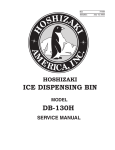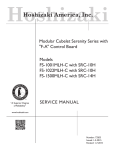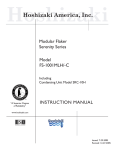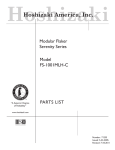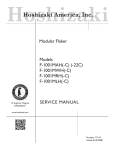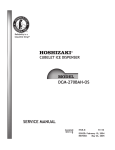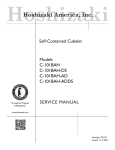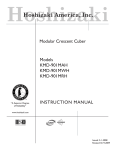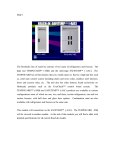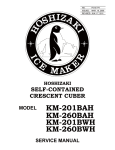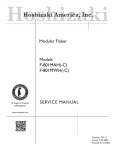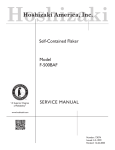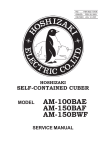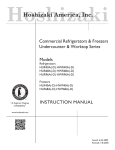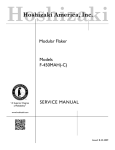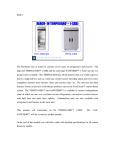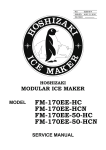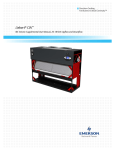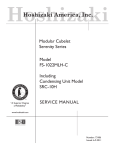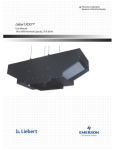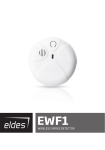Download FS-1001MLH(-C) Service Manual
Transcript
73122 NO: ISSUED: September 12, 2005 HOSHIZAKI MODULAR FLAKER MODEL FS-1001MLH/-C ALSO COVERS HOSHIZAKI CONDENSING UNIT MODEL SRC-10H SERVICE MANUAL IMPORTANT Only qualified service technicians should attempt to service or maintain this icemaker. No such service or maintenance should be undertaken until the technician has thoroughly read this Service Manual. HOSHIZAKI provides this manual primarily to assist qualified service technicians in the service and maintenance of the icemaker. Should the reader have any questions or concerns which have not been satisfactorily addressed, please call or write to the HOSHIZAKI Technical Support Department for assistance. HOSHIZAKI AMERICA, INC. 618 Highway 74 South Peachtree City, GA 30269 Attn: HOSHIZAKI Technical Support Department Phone: 1-800-233-1940 Technical Service (770) 487-2331 Fax: 1-800-843-1056 (770) 487-3360 Web Site: www.hoshizakiamerica.com NOTE: To expedite assistance, all correspondence/communication MUST include the following information: • Model Number • Serial Number • Complete and detailed explanation of the problem 2 Please review this manual. It should be read carefully before the icemaker is serviced or maintenance operations are performed. Only qualified service technicians should service and maintain the icemaker. This manual should be made available to the technician prior to service or maintenance. CONTENTS I. Specifications .................................................................................................................... 5 A. Icemaker ...................................................................................................................... 5 1. FS-1001MLH .......................................................................................................... 5 2. FS-1001MLH-C ...................................................................................................... 6 B. Condensing Unit .......................................................................................................... 7 1. SRC-10H ................................................................................................................ 7 II. General Information .......................................................................................................... 8 A. Dimensions .................................................................................................................. 8 1. Icemaker ................................................................................................................. 8 a) FS-1001MLH/-C ................................................................................................ 8 2. Condensing Unit ..................................................................................................... 9 a) SRC-10H .......................................................................................................... 9 B. Construction ............................................................................................................... 10 1. Icemaker ............................................................................................................... 10 a) FS-1001MLH/-C .............................................................................................. 10 2. Condensing Unit ................................................................................................... 11 a) SRC-10H ........................................................................................................ 11 C. Control Box Layout .................................................................................................... 12 1. Icemaker ............................................................................................................... 12 a) FS-1001MLH/-C .............................................................................................. 12 2. Condensing Unit ................................................................................................... 13 a) SRC-10H ........................................................................................................ 13 III. Technical Information ..................................................................................................... 14 A. Water Circuit and Refrigeration Circuit ....................................................................... 14 1. Icemaker ............................................................................................................... 14 a) FS-1001MLH/-C .............................................................................................. 14 2. Condensing Unit ................................................................................................... 15 a) SRC-10H ........................................................................................................ 15 B. Wiring Diagram .......................................................................................................... 16 1. Icemaker ............................................................................................................... 16 a) FS-1001MLH/-C .............................................................................................. 16 2. Condensing Unit ................................................................................................... 17 a) SRC-10H ........................................................................................................ 17 C. Sequence of Electrical Circuit .................................................................................... 18 1. Icemaker ............................................................................................................... 18 D. Timing Chart .............................................................................................................. 27 E. Performance Data ...................................................................................................... 30 1. FS-1001MLH ........................................................................................................ 30 2. FS-1001MLH-C .................................................................................................... 31 3 IV. Service Diagnosis .......................................................................................................... 32 A. No Ice Production ...................................................................................................... 32 1. Icemaker ............................................................................................................... 32 2. Condensing Unit ................................................................................................... 34 B. Low Ice Production .................................................................................................... 34 C. Other .......................................................................................................................... 35 V. Removal and Replacement of Components ................................................................... 36 A. Service for Refrigerant Lines ...................................................................................... 36 1. Refrigerant Recovery ........................................................................................... 36 2. Evacuation and Recharge [R-404A] ..................................................................... 36 a) Complete ......................................................................................................... 36 b) Partial evacuation with pumpdown ................................................................. 37 B. Brazing ....................................................................................................................... 38 C. Service for Condensing Unit ...................................................................................... 39 1. Removal and Replacement of Compressor .......................................................... 39 2. Removal and Replacement of Condensing Pressure Regulator (C.P.R.) ............. 40 D. Removal and Replacement of Drier ........................................................................... 41 E. Removal and Replacement of Expansion Valve ........................................................ 42 F. Removal and Replacement of Evaporator Assembly ................................................. 43 G. Removal and Replacement of Control Water Valve ................................................... 47 H. Removal and Replacement of Flush Water Valve ...................................................... 48 VI. Cleaning and Maintenance ........................................................................................... 49 A. Preparing the Icemaker for Long Storage ................................................................... 49 B. Cleaning and Sanitizing Instructions .......................................................................... 50 1. Cleaning Solution ................................................................................................. 50 2. Cleaning Procedure ............................................................................................. 50 3. Sanitizing Solution ............................................................................................... 52 4. Sanitizing Procedure - Initial ................................................................................. 52 5. Sanitizing Procedure - Final ................................................................................. 53 C. Maintenance Instructions ........................................................................................... 55 4 I. Specifications A. Icemaker 1. FS-1001MLH No Data Available We reserve the right to make changes in specifications and design without prior notice. 5 2. FS-1001MLH-C AC SUPPLY VOLTAGE GEAR MOTOR OTHER MAXIMUM FUSE SIZE MAX. HACR BREAKER (USA ONLY) MAX. CIRC. BREAKER (CANADA ONLY) MINIMUM CIRCUIT AMPACITY APPROXIMATE ICE PRODUCTION PER 24 HR. lbs./day ( kg/day ) Reference without *marks SHAPE OF ICE ICE QUALITY APPROXIMATE STORAGE CAPACITY ELECTRIC & WATER CONSUMPTION ELECTRIC W (kWH/100 lbs.) ELECTRIC W (kWH/100 lbs.) POTABLE WATER gal./24HR (gal./100 lbs.) EXTERIOR DIMENSIONS (WxDxH) EXTERIOR FINISH WEIGHT CONNECTIONS - ELECTRIC - WATER SUPPLY - DRAIN - REFRIGERATION CIRCUIT ICE MAKING SYSTEM HARVESTING SYSTEM ICE MAKING WATER CONTROL COOLING WATER CONTROL BIN CONTROL SYSTEM (Primary) BIN CONTROL SYSTEM (Secondary) CONDENSING UNIT EVAPORATOR REFRIGERANT CONTROL REFRIGERANT CHARGE DESIGN PRESSURE P.C. BOARD CIRCUIT PROTECTION GEAR MOTOR PROTECTION LOW WATER PROTECTION ACCESSORIES -SUPPLIED -REQUIRED OPERATING CONDITIONS 115/60/1 120 V 3 FLA 1/4 HP 120 V 0.03A 15 A 15 A 15 A 15 A Ambient WATER TEMP. (°F) Temp.(°F) 50 70 90 70 *830 (380) 805 (365) 785 (355) 80 765 (350) 750 (340) 730 (330) 90 710 (325) *705 (320) 680 (310) 100 660 (300) 650 (295) *600 (275) Cubelet Approx. 80%, Ice (90/70°F, Conductivity 200 µs/cm) N/A 90/70°F 70/50°F 1745 (5.96) 1713 (4.94) FS-1001MLH-C & SRC-10H FS-1001MLH-C ONLY 331 (1.13) 345 (1.00) 84 (12) 100 (12) 30" x 11" x 26" (766 x 279 x 660mm) Stainless Steel Net 126 lbs. ( 57 kg ), Shipping 166 lbs. ( 75 kg ) Cord Connection Inlet 1/2" FPT Outlet 3/4" FPT Suction line 1-1/16-12 UNF Fitting (#10 AEROQUIP) Liquid line 5/8-18 UNF Fitting (#6 AEROQUIP) Auger type Direct Driven Auger ( 1/4 HP Gear Motor ) Float Switch N/A Photoelctric Sensor Mechanical Bin Control ( Proximity Sw. ) Air-cooled Remote Condensing unit SRC-10H Required Copper Tube on Cylinder Thermostatic Expansion Valve Condensing Pressure Regulator on SRC-10H R-404A, 8 lb.6oz. (3800g) (Ice Maker: 4 oz., Cond. Unit: 8 lb. 2 oz. ) High 427 PSIG, Low 230 PSIG Fuse (1A) Fuse (3A) Float Switch and Timer Spare Fuse Ice Storage Bin VOLTAGE RANGE 104-127 V AMBIENT TEMP. 45-100° F WATER SUPPLY TEMP. 45-90° F WATER SUPPLY PRESSURE 10-113 PSIG We reserve the right to make changes in specifications and design without prior notice. 6 B. Condensing Unit 1. SRC-10H AC SUPPLY VOLTAGE COMPRESSOR FAN MOTOR OTHER MAXIMUM FUSE SIZE MAX. HACR BREAKER (USA ONLY) MAX. CIRC. BREAKER (CANADA ONLY) MINIMUM CIRCUIT AMPACITY EXTERIOR DIMENSIONS (WxDxH) DIMENSIONS WITH LEGS (WxDxH) EXTERIOR FINISH WEIGHT (approximate) CONNECTIONS - ELECTRIC - REFRIGERATION CIRCUIT COMPRESSOR CONDENSER FAN MOTOR PROTECTION REFRIGERATION PROTECTION REFRIGERANT CONTROL PUMPDOWN CONTROL REFRIGERANT CHARGE DESIGN PRESSURE COMPRESSOR PROTECTION ACCESSORIES -SUPPLIED OPERATING CONDITIONS 208-230/60/1 (3 WIRE W/ NEUTRAL FOR 115V) 208-230 9.6 RLA 46 LRA 120 V 3A MAX 120 V 0.5 A 20 A 20 A 20 A 20 A 28-1/4" x 23" x 19-7/8" (717 x 584 x 506mm) 30-1/4" x 25-3/8" x 34-7/8" (770 x 645 x 886mm) Galvanized Steel Net 143 lbs. ( 65 kg ), Shipping 169 lbs. ( 77 kg ) Permanent - Connection Discharge line 1-1/16-12 UNF Fitting (#10 AEROQUIP) Liquid line 5/8-18 UNF Fitting (#6 AEROQUIP) Hermetic, Model RS80-C2E-CAV Air-cooled fin and tube type Thermal Protector Auto-reset High Pressure Switch, Manual low Pressure Switch Condenser Pressure Regulator Auto-reset Low Pressure Switch R-404A, 8 lb.6oz. (3800g) (Ice Maker: 4 oz., Cond. Unit: 8 lb. 2 oz. ) High 427 PSIG, Low 230 PSIG Internal Protector Leg 2 pcs. Hex. Head Bolt w/ Washer 8X16 8 pcs. Hex. Nut 8 pcs. VOLTAGE RANGE 187-253 V AMBIENT TEMP. -4-122° F HEAT OF REJECTION 10500 BTU/hr We reserve the right to make changes in specifications and design without prior notice. 7 II. General Information A. Dimensions Unit = inches [mm] 1. Icemaker a) FS-1001MLH/-C 8 2. Condensing Unit a) SRC-10H Unit = [inches] mm 9 B. Construction 1. Icemaker a) FS-1001MLH/-C Water Supply Inlet Control Water Valve Bin Control Power Supply Cord Control Box Ice Chute Evaporator Expansion Valve Gear Motor Beam Sensor Drier Flush Water Valve 10 2. Condensing Unit a) SRC-10H Condenser Pressure Regulator Condenser Fan Motor Receiver Tank Control Box Compressor 11 C. Control Box Layout 1. Icemaker a) FS-1001MLH/-C Capacitor Transformer Flush Switch Cam Timer Power Switch Water Control Relay Fuse (Timer Board 1A) Gear Motor Relay Fuse (Gear Motor 3A) Connector Timer Board Time Delay Relay Connector 12 2. Condensing Unit a) SRC-10H Pressure Switch Low Pressure Switch 2 (Safety) Cut-out 3 psig Cut-in 6 psig (manual reset) Low Pressure Switch 1 (Control) Cut-out 9 psig Cut-in 29 psig Starter (Relay) Magnetic Contactor Capacitor Capacitor - Start Capacitor - Run 13 III. Technical Information A. Water Circuit and Refrigeration Circuit 1. Icemaker a) FS-1001MLH/-C 14 2. Condensing Unit a) SRC-10H 15 B. Wiring Diagram 1. Icemaker a) FS-1001MLH/-C 16 2. Condensing Unit a) SRC-10H 17 C. Sequence of Electrical Circuit 1. Icemaker 1. When the power switch is moved to the “ON” position and the flush switch to the “ICE” position, water starts to be supplied to the reservoir. 18 2. When the reservoir has been filled, the gear motor starts immediately. 19 3. The pumpdown solenoid valve energizes about 60 sec. after the gear motor starts. ! 20 4a. The bin control sensor operates and the pumpdown solenoid deenergizes after a time delay set by the user. 60 seconds after that the gear motor stops. 21 4b. Should the bin control sensor fail and the bin control switch operate, the pumpdown solenoid valve and gear motor will stop simultaneously 6 sec. after operation. 22 5. Low water. 23 6. When the flush switch is moved to the “FLUSH” position, the flush water valve opens and flushes the reservoir and evaporator. 24 7. When the flush timer operates (for 15 min. every 12 hours). 25 8. If the gear motor fuse (3A) blows, the solenoid valve and gear motor will turn off immediately. ! 26 D. Timing Chart Bin Control Switch Off On 1. Water Level 2. Float Switch Upper Lower Bottom Upper On Off On Lower Off 3. Water Control On Off Relay 4. Control Water On Off Valve 5. Flush Timer 1-2 2-3 6. Flush Switch Flush Ice 7. Flush Water Valve On Off 8. Bin Control On Off 1 sec 9. Gear Motor Relay On Off 10. Gear Motor On Off 11. Fan Motor On Off 6 sec 60 sec 12. Pumpdown Solenoid On Off 13. Heater On Off 1 sec 60 sec 27 Low Water/Bin Control Sensor 1. Water Level 2. Float Switch Flush Timer Upper Lower Bottom Upper On Off On Lower Off 3. Water Control On Relay Off 4. Control Water On Off Valve 5. Flush Timer 1-2 2-3 6. Flush Switch Flush Ice 7. Flush Water Valve On Off 8. Bin Control On Off 21min every 12 hr 150 sec 9. Gear Motor Relay On Off 10. Gear Motor On Off 11. Fan Motor On Off 90 sec 12. Pumpdown Solenoid On Off 13. Heater On Off 1sec 150 sec 60 sec 28 90 sec 1sec 60 sec Flush Switch 1. Water Level 2. Float Switch Pressure Switch Off On Ice Flush Upper Lower Bottom Upper On Off On Lower Off 3. Water Control On Off Relay 4. Control Water On Off Valve 5. Flush Timer 1-2 2-3 6. Flush Switch Flush Ice 7. Flush Water Valve On Off 8. Bin Control On Off 150 sec 9. Gear Motor Relay On Off 10. Gear Motor On Off 11. Fan Motor On Off 1sec 90 sec 12. Pumpdown Solenoid 60 sec 1sec 60 sec On Off 1sec 13. Heater On Off 29 E. Performance Data 1. FS-1001MLH No Data Available We reserve the right to make changes in specifications and design without prior notice. 30 2. FS-1001MLH-C Performance Data: APPROXIMATE ICE PRODUCTION PER 24 HR. Ambient Temp. (F) 70 80 90 lbs./DAY ( l/day) 100 APPROXIMATE ELECTRIC 70 CONSUMPTION 80 90 watts 100 APPROXIMATE WATER 70 CONSUMPTION PER 24 HR. 80 90 gal. / day (l/day) 100 EVAPORATOR OUTLET TEMP. 70 F ( C) 80 90 100 HEAD PRESSURE 70 80 90 PSIG (kg/sq.cmG) 100 SUCTION PRESSURE 70 PSIG (kg/sq.cmG) 80 90 100 HEAT OF REJECTION FROM BODY Water Temp. (F) 70 90 803 365 784 356 378 347 747 340 729 331 324 *703 320 679 309 301 647 294 *600 273 -1717 -1722 --1731 -1736 --1745 -1760 --1789 -1804 -96 364 94 356 377 347 90 339 88 331 323 *84 319 81 308 301 78 293 *72 272 -10 14 -10 14 -10 -10 16 -9 16 -9 -9 *16 -9 18 -8 -8 18 -8 *18 -8 15.7 224 15.7 224 15.7 16.4 233 16.4 233 16.4 17.0 *242 17.0 242 17.0 19.6 279 19.6 *279 19.6 2.0 29 2.0 29 2.0 2.1 30 2.1 30 2.1 2.2 *31 2.2 31 2.2 2.3 33 2.3 *33 2.3 1130 BTU/hr AT 90 F/WT 70 F 50 *832 765 712 663 1713 1727 1740 1775 *100 92 85 80 *14 14 16 18 *224 233 242 279 *29 30 31 33 Note: The data without *marks should be used for reference. We reserve the right to make changes in specifications and design without prior notice. 31 IV. Service Diagnosis A. No Ice Production 1. Icemaker Problem Possible Cause [1] The icemaker will not a) Power Supply start. 1. OFF position. Remedy 1. Move to ON position. 2. Loose connection. 2. Tighten. 3. Bad contacts. 3. Check for continuity and replace. 4. Blown fuse. 1. Off position. 4. Replace. 1. Move to ON position. 2. Bad contacts. 2. Check for continuity and replace. c) Fuse (Control Box) 1. Blown out. 1. Check for short circuit and replace. d) Circuit Protect Relay 1. Miswiring. 1. Check power supply voltage and wire properly. e) Flush Timer 1. Flushing out. 2. Bad contacts. 1. Wait for 15 minutes. 2. Check for continuity and replace. f) Flush Switch 1. FLUSH position. 1. Move to ICE position. 2. Bad contacts. 2. Check for continuity and replace. g) Transformer 1. Coil winding opened. 1. Replace. h) Control Water Valve 1. Coil winding opened. 1. Replace. b) Power Switch (Control Box) i) Shut-off Valve j) Plug and Receptacle (Control Box) k) Bin Control Sensor [2] Water does not stop, a) Water Control Relay and the icemaker will not start. b) Float Switch c) Flush Water Valve d) Hoses 1. Closed. 1. Open. 2. Water failure. 2. Wait until water is supplied. 1. Disconnected. 1. Connect. 2. Terminal out of plug or 2. Insert terminal back in receptacle. position. 1. Failed sensor. 1. Check LED with power switch on. Replace if necessary. 2. Wet or scaled eye. 2. Wipe off and clean sensor eye. 1. Contact fused. 1. Replace. 2. Coil winding opened. 2. Replace. 1. Bad contacts. 1. Check for continuity and replace. 2. Clean or replace. 2. Float does not move freely. 1. Valve seat clogged and water leaking. 1. Disconnected. 32 1. Clean or replace. 1. Connect. Problem [3] Water has been supplied, but the icemaker will not start. Possible Cause a) Water Control Relay Remedy 1. Check for continuity and replace. 1. Bad contacts. b) Bin Control 1. Bad contacts. 1. Check for continuity and replace. 2. Actuator does not move freely. 2. Clean shaft and its corresponding holes or replace bin control. 3. Make sure that sensor 3. Clear/clean sensor eye. eye is clear. c) Gear Motor Relay [4] Water has been supplied, but gear motor will not start and solenoid will not energize. [5] Gear motor starts and solenoid energizes, but machine does not make ice or makes ice intermittently. 1. Coil winding opened. 1. Replace. 2. Bad contacts. 2. Check for continuity and replace. 1. Replace. d) Control Timer 1. Broken. (Printed Circuit Board) a) Gear Motor Fuse 1. Blown fuse. (BUSSMAN GMD 3.0A) b) Thermal Protector (Gear Motor) 1. Bad contacts. 1. Check for continuity and replace. a) High Pressure Switch 1. Dirty condenser. 1. Clean. 2. Ambient air 2. Need cooler conditions. temperature at condensing unit too warm. 3. Refrigerant 3. Recharge. overcharged. 4. Refrigerant line or 4. Clean and replace drier. components plugged. 5. Bad contacts. 6. Loose connections. [6] Gear motor starts, but solenoid valve will not energize or energizes intermittently. 1. See "C. [3]." Determine the cause and replace the fuse. a) X2 Relay on Control Timer b) Solenoid Valve [7] Gear motor starts a) Refrigerant Line and solenoid energizes, but no ice is produced. 5. Check for continuity and replace. 6. Tighten. 1. Bad contacts. 1. Check for continuity and replace. 2. Coil winding opened. 2. Replace timer. 1. Bad contacts. 2. Coil winding opened. 1. Check for continuity and replace. 2. Replace coil. 3. Valve stuck closed. 3. Replace valve body. 1. Gas leaks. 1. Check for leaks with a leak detector. Reweld leak, replace drier and charge with refrigerant. The amount of refrigerant is marked on nameplate or label. 2. Replace clogged component. 2. Refrigerant line clogged. 33 Problem [7] Continued from previous page. Possible Cause b) Condensing Unit 1. Not functioning properly. Remedy 1. Proceed to "2. Condensing Unit." 1. OFF position. Remedy 1. Turn supply on. 2. Incorrect wiring. 2. Correct wiring. 2. Condensing Unit Problem Possible Cause [8] Condensing unit does a) Power Supply not start. [9] Compressor will not start or operates intermittently. b) Secondary Low 1. Awaiting reset. Pressure Switch c) Ice Machine 1. Ice machine off. a) Low Pressure Switches 1. Faulty or malfunctioning. b) Magnetic Contactor 1. Coil winding opened. c) Starter 1. Bad contacts. 1. Find cause and press Reset button. 1. Turn on ice machine. 1. Check for continuity and replace. 1. Replace. 1. Check for continuity and replace. 2. Coil winding opened. 2. Replace. 3. Loose connections. 3. Tighten. d) Start or Run Capacitor 1. Defective. e) Compressor 1. Loose connections. 1. Replace. 1. Tighten. 2. Motor winding open or 2. Replace. grounded. 3. Motor protector 3. Find cause of overcurrent tripped. or overheat. f) Power Supply 1. Circuit Ampacity too low. 1. Install larger conductor. B. Low Ice Production Problem [1] Low ice production. Possible Cause a) Refrigerant Line 2. Refrigerant line clogged. Remedy 1. See "A. 1. [7] a) Refrigerant Line." 2. Replace the clogged component. 3. Overcharged. 3. Recharge. 1. Gas leaks. b) High-side Pressure Too 1. Dirty condenser. 1. Clean. High 2. Ambient air 2. Need cooler conditions. temperature at condensing unit too warm. 3. Condensing unit out of 3. Check condensing unit. order. c) Expansion Valve (not adjustable) 1. Low-side pressure too 1. Replace. low. 2. Low-side pressure too 2. See if expansion valve high. bulb is mounted properly, and replace the valve if necessary. 34 C. Other Problem [1] Abnormal noise. Possible Cause a) Refrigerant Lines b) Gear Motor (Ice Making) c) Evaporator [2] Overflow from a) Water Supply reservoir (Water does b) Control Water Valve not stop.) c) Float Switch [3] Gear motor fuse blown frequently. 1. Rub or touch lines or other surfaces. 1. Bearing or gear worn out / damaged. c) Bin Control 1. Replace. 1. Too much pressure 1. Replace. loss. 2. Scale on inside wall of 2. Remove auger. Use freezing cylinder. "SCALE AWAY" or "LIMEA-WAY" solution to clean periodically. If the water is found hard by testing, install a softener. 1. Water pressure too high. 1. Diaphragm does not close. 1. Bad contacts. a) Power Supply Voltage 1. Too high or too low. b) Ice Making Unit Remedy 1. Replace. 1. Bearings or auger worn out. 1. Bad contacts. 2. Actuator does not move freely. 35 1. Install a pressure reducing valve. 1. Clean or replace. 1. Check for continuity and replace. 1. Connect the unit to a power supply of proper voltage. 1. Replace bearings or auger. 1. Check for continuity and replace. 2. Clean shaft and its corresponding holes or replace bin control. V. Removal and Replacement of Components IMPORTANT Ensure all components, fasteners and thumbscrews are securely in place after the equipment is serviced. IMPORTANT 1. The Polyolester (POE) oils used in R-404A units can absorb moisture quickly. Therefore it is important to prevent moisture from entering the system when replacing or servicing parts. 2. Always install a new filter drier every time the sealed refrigeration system is opened. 3. Do not leave the system open for longer than 15 minutes when replacing or servicing parts. A. Service for Refrigerant Lines 1. Refrigerant Recovery The icemaker unit is provided with two refrigerant service valves - one on the low-side and one on the high-side line. Using proper refrigerant practices recover the refrigerant from the service valves and store it in an approved container. Do not discharge the refrigerant into the atmosphere. 2. Evacuation and Recharge [R-404A] a) Complete For complete evacuation of ice machine and condensing unit, follow the steps below. Note: For replacement of components inside the ice machine, a complete evacuation is not necessary. For partial evacuation with pumpdown, see “Partial evacuation with pumpdown” below. 1) Attach charging hoses, a service manifold and a vacuum pump to the system. Be sure to connect charging hoses to both high-side and low-side service valves. WARNING Service valves have no valve core. Be sure valve stems are closed before removing the flare caps to attach charging hoses. IMPORTANT The vacuum level and vacuum pump may be the same as those for current refrigerants. However, the rubber hose and gauge manifold to be used for evacuation and refrigerant charge should be exclusively for POE oils. 36 2) Turn on the vacuum pump. Never allow the oil in the vacuum pump to flow backwards. 3) Allow the vacuum pump to pull down to a 29.9" Hg vacuum. Evacuating period depends on pump capacity. 4) Close the low-side valve and high-side valve on the service manifold. 5) Disconnect the vacuum pump and attach a refrigerant service cylinder to the high-side line. Remember to loosen the connection and purge the air from the hose. See the rating label on the control box in the icemaker for the required refrigerant charge. Hoshizaki recommends only virgin refrigerant or reclaimed refrigerant which meets ARI Standard No. 700-88 be used. 6) A liquid charge is recommended for charging an R-404A system. Invert the service cylinder if necessary. Open the high-side, service manifold valve. 7) Allow the system to charge with liquid until the pressures balance. 8) If necessary, add any remaining charge to the system through the low-side. Use a throttling valve or liquid dispensing device to add the remaining liquid chargethrough the low-side access port with the unit running. 9) Close the two refrigerant service valves and disconnect the hoses and service manifold. WARNING Service valves have no valve core. Be sure valve stems are closed before disconnecting the hoses. 10) Cap the service valves to prevent a possible leak. b) Partial evacuation with pumpdown For replacement of components inside the ice machine, only a partial evacuation with pumpdown is necessary. 1) If not already running, turn on the ice machine, making sure that the solenoid valve energizes and that the bin control is not activated. 2) Turn off the power supply to the condensing unit. 3) In the condensing unit, close the liquid line shut-off valve by rotating the valve stem clockwise until it is fully seated. 37 4) Turn the power supply to the condensing unit back on. 5) Once the automatic pumpdown cycle is complete and the condensing unit shuts itself down, turn off the power supply to the condensing unit. 6) Close the suction line shut-off valve by rotating the valve stem clockwise until it is fully seated. 7) See “1. Refrigerant Recovery” for instructions to recover remaining charge left in line sets and ice machine. 8) When service is complete, evacuate line set and ice machine to 29.9” Hg vacuum. 9) Recharge ice machine and line set with 50g of R-404A refrigerant. 10) Close the two refrigerant service valves and disconnect the charging hoses, replacing the flare caps on the service valves when finished. WARNING Service valves have no valve core. Be sure valve stems are closed before disconnecting the hoses. 11) At the condensing unit, open both the liquid line and suction line shutoff valves. 12) Turn the power supply to the condensing unit back on. B. Brazing DANGER 1. Refrigerant R-404A itself is not flammable at atmospheric pressure and temperatures up to 176° F. 2. Refrigerant R-404A itself is not explosive or poisonous. However, when exposed to high temperatures (open flames) R-404A can be decomposed to form hydrofluoric acid and carbonyl fluoride both of which are hazardous. 3. Always recover the refrigerant and store it in an approved container. Do not discharge the refrigerant into the atmosphere. 4. Do not use silver alloy or copper alloy containing arsenic. 5. Do not use R-404A as a mixture with pressurized air for leak testing. Refrigerant leaks can be detected by charging the unit with a little refrigerant, raising the pressure with nitrogen and using an electronic leak detector. 38 C. Service for Condensing Unit Note: 1. The condensing unit is wired independently from the icemaker. The compressor and condenser fan motor energize when the suction line primary low pressure switch closes. This switch has a cut-out point of 9 psig and a cut-in point of 29 psig. Because of the independent wiring, the condensing unit may periodically energize for short periods of time in order to keep suction pressures from building. This is an automatic, continuous pumpdown and is perfectly normal for the machine. 2. A secondary low pressure switch exists in the suction line to ensure that the machine will not be damaged should the primary switch fail. It has a cut-out point of 3 psig and a differential of 6 psi. The switch is also equipped with a manual reset, so that if it activates and shuts the condensing unit down it must be reset after the cause of the failure has been found. 1. Removal and Replacement of Compressor IMPORTANT Always install a new drier every time the sealed refrigeration system is opened. Do not replace the drier until after all other repair or replacements have been made. 1) Turn off the power supply, and remove the panels. 2) Remove the terminal cover on the compressor and disconnect the compressor wiring. 3) Recover the refrigerant and store it in an approved container, if required by an applicable law. 4) Remove the discharge, suction and access pipes from the compressor using brazing equipment. WARNING When repairing a refrigerant system, be careful not to let the burner flame contact any electrical wires or insulation. 5) Remove the bolts and rubber grommets. 6) Slide and remove the compressor. Unpack the new compressor package. Install the new compressor. 7) Attach the rubber grommets of the prior compressor. 39 8) Sandpaper the discharge, suction and access pipes. 9) Place the compressor in position and secure it using the bolts. 10) Remove plugs from the discharge, suction and access pipes. 11) Braze the access, suction and discharge lines (Do not change this order), while purging with nitrogen gas flowing at a pressure of 3 - 4 psig. 12) Install the new drier in the icemaker. 13) Check for leaks using nitrogen gas (140 psig) and soap bubbles. 14) Evacuate the system, and charge it with refrigerant. See the rating label on the control box in the icemaker for the required refrigerant charge and type. 15) Connect the terminals to the compressor, and replace the terminal cover in its correct position. 16) Replace the panels in their correct positions, and turn on the power supply. 2. Removal and Replacement of Condensing Pressure Regulator (C.P.R.) IMPORTANT Always install a new drier every time the sealed refrigeration system is opened. Do not replace the drier until after all other repairs or replacements have been made. 1) Turn off the power supply to the condensing unit. 2) Remove the panels from the condensing unit. 3) See chapter V, section A. 2. a) and perform the complete evacuation procedure. 4) Recover the refrigerant and store it in an approved container. 5) Remove the C.P.R. using brazing equipment. 6) Braze the new C.P.R. with nitrogen gas flowing at a pressure of 3 - 4 psig. WARNING Always protect the C.P.R. body by using a damp cloth to prevent the C.P.R. from overheating. Do not braze with the C.P.R. body exceeding 250°F. 40 7) Install the new drier in the icemaker. 8) Check for leaks using nitrogen gas (140 psig) and soap bubbles. 9) Evacuate the system. Charge it with refrigerant. See the rating label on the control box in the icemaker. 10) Replace the panels in their correct position. 11) Turn on the power supply D. Removal and Replacement of Drier IMPORTANT Always install a new drier every time the sealed refrigeration system is opened. Do not replace the drier until after all other repair or replacements have been made. 1) Turn off the power supply, and remove the panels. 2) See chapter V, section A. 2. for evacuation procedure. 3) Recover the refrigerant and store it in an approved container, if required by applicable law. 4) Remove the drier using brazing equipment. 5) Install the new drier with the arrow on the drier in the direction of the refrigerant flow. Use nitrogen gas at a pressure of 3 - 4 psig when brazing the tubings. 6) Check for leaks using nitrogen gas (140 psig) and soap bubbles. 7) Evacuate the system, and charge it with refrigerant. See the rating label on the control box in the icemaker for the required refrigerant charge and type. 8) Replace the panels in their correct position and turn on the power supply. 41 E. Removal and Replacement of Expansion Valve IMPORTANT Sometimes moisture in the refrigerant circuit exceeds the drier capacity and freezes up at the expansion valve. Always install a new drier every time the sealed refrigeration system is opened. Do not replace the drier until after all other repairs or replacements have been made. 1) Turn off the power supply, and remove the panels. 2) See chapter V, section A. 2. for evacuation procedure. 3) Recover the refrigerant and store it in an approved container, if required by applicable law. 4) Remove the expansion valve bulb at the evaporator outlet. 5) Remove the expansion valve cover and remove the expansion valve using brazing equipment. 6) Braze the new expansion valve with nitrogen gas flowing at a pressure of 3 - 4 psig. WARNING Always protect the valve body by using a damp cloth to prevent the valve from overheating. Do not braze with the valve body exceeding 250°F. 7) Install the new drier. 8) Check for leaks using nitrogen gas (140 psig) and soap bubbles. 9) Evacuate the system. Charge it with refrigerant. See the rating label on the control box in the icemaker for the required refrigerant charge and type. 10) Attach the bulb to the suction line and make it level. Be sure to secure the bulb using a band and to insulate it. 11) Place the new set of expansion valve covers in position. 12) Replace the panels in their correct position and turn on the power supply. 42 F. Removal and Replacement of Evaporator Assembly 1) Turn off the power supply. 2) Remove the panels. 3) Move the flush switch to the “FLUSH” position. 4) Turn on the power supply and drain out all water from the water line. 5) Turn off the power supply. 6) Remove the strap connecting the spout to the chute assembly. 7) Remove the three thumbscrews and take off the spout from the evaporator. Cutter 8) Remove the bolt and lift off the cutter. 9) Remove the rubber O-ring and the nylon ring at the top of the evaporator. Extruding Head 10) Replace the bolt in the auger shaft. Use the bolt to move the auger towards you and then try to insert a .02” round stock or pin gauge in between the back side of the auger shaft and the bearing surface. Check several locations around the auger shaft. If the gauge goes between the shaft and the bearing at any point, both the top bearing in the extruding head and the lower bearing in the housing should be replaced. Instructions for removing the housing are located later in this procedure. .02” Round Stock or Pin Gauge Auger Extruding Head Note: Replacing the bearing requires a bearing press adaptor. If one is not available, replace the whole extruding head and housing. 11) Remove the four socket head cap screws and lift off the extruding head. Auger 12) Lift off the auger. If the area in contact with the bearing is worn out or the blade scratched, replace the auger. 43 Evaporator Note: Skip the following steps 13) through 15) when the evaporator does not need replacement. 13) See chapter V, section A. 2. b) and perform the partial evacuation procedure. 14) Recover the refrigerant and store it in an approved container, if required by an applicable law. IMPORTANT Always install a new drier every time the sealed refrigeration system is opened. Do not replace the drier until after all other repair or replacements have been made. 15) Remove the bulb of the expansion valve. 16) Disconnect the brazing-connections of the expansion valve and the copper tube-low side from the evaporator, using brazing equipment. 17) Remove the two truss head machine screws and the strap securing the evaporator. 18) Disconnect the two hoses from the evaporator. 19) Remove the four socket head cap screws securing the evaporator to the housing. 20) Lift off the evaporator. Housing, Lower Bearing and Mechanical Seal 21) The mechanical seal consists of two parts. One moves along with the auger, and the other is fixed on the housing. If the contact surfaces of these two parts are worn or scratched, the mechanical seal may cause water leaks and should be replaced. 22) Remove the O-ring from the housing. 23) Remove the six bolts and the housing from the gear motor. If inspection of the bearing inside the extruding head (earlier in this procedure) indicated that it is out of tolerance, replace both it and the bearing inside the housing. Note: Replacing the bearing requires a bearing press adaptor. If one is not available, replace the whole extruding head and housing. 44 Gear Motor 24) Remove the coupling-spline on the gear motor shaft. 25) Remove the barrier on the top of the gear motor. 26) Remove the three socket head cap screws securing the gear motor. 27) Assemble the removed parts in the reverse order of the above procedure. WARNING Be careful not to scratch the surface of the O-ring or it may cause water leaks. Handle the mechanical seal with care not to scratch or contaminate its contact surface. 28) When replacing the evaporator; (a) Braze the new evaporator with nitrogen gas flowing at a pressure of 3 - 4 psig. Be careful not to burn the evaporator insulation. (b) Replace the drier. (c) Check for leaks using nitrogen gas (140 psig) and soap bubbles. (d) Evacuate the system. Charge it with refrigerant. 29) Move the flush switch to the “ICE” position. 30) Replace the panels in their correct position. 31) Turn on the power supply. 45 Rubber O-ring Nylon Ring Bolt Dowel Pin Cutter Washer Extruding Head Heater with Spring Washer Socket Head Cap Screw Evaporator Split Lock Washer Socket Head Cap Screw Auger Mechanical Seal O-ring Hex Head Bolt Spring Washer Washer Housing Truss Head Screw Coupling - Spline Barrier - Gear Motor Gear Motor 46 G. Removal and Replacement of Control Water Valve 1) Turn off the power supply, remove the panels and close the water supply line shut-off valve. 2) Disconnect the terminals from the control water valve. 3) Loosen the fitting nut on the control water valve inlets and remove the control water valve. Do not lose the packings inside the fitting nut. 4) Remove the water supply hose from the control water valve. 5) Install the new control water valve. 6) Assemble the removed parts in the reverse order of the above procedure. 7) Open the water supply line shut-off valve. 8) Check for water leaks. 9) Replace the panels in their correct position, then turn on the power supply. 47 H. Removal and Replacement of Flush Water Valve 1) Turn off the power supply, remove the panels and close the water supply line shut-off valve. 2) Remove the clamp and disconnect the flush water valve. Note: Water may still remain inside the evaporator. Be sure to drain the water into the drain pan. 3) Disconnect the terminals from the flush water valve. 4) Remove the flush water valve from the bracket. 5) Remove the drain pipe from the flush water valve. 6) Connect the drain pipe to the new flush water valve and place the valve in position. 7) Connect the hose to the flush water valve and secure it with the clamp. 8) Pour water into the reservoir and check for water leaks on the flush water valve. 9) Open the water supply line shut-off valve, then turn on the power supply. 10) Move the flush switch to the “ICE” position. 11) Check for water leaks. 12) Move the flush switch to the “FLUSH” position and make sure water is flushing. 13) Move the flush switch to the “ICE” position. 14) Replace the panels in their correct position. 48 VI. Cleaning and Maintenance IMPORTANT Ensure all components, fasteners and thumbscrews are securely in place after any maintenance or cleaning is done to the equipment. A. Preparing the Icemaker for Long Storage WARNING When shutting off the icemaker for an extended time, drain out all water from the water line and remove the ice from the storage bin. The storage bin should be cleaned and dried. Drain the icemaker to prevent damage to the water supply line at sub-freezing temperatures, using air or carbon dioxide. Shut off the icemaker until the proper ambient temperature is resumed. 1) Run the icemaker with the water supply line shut-off valve closed. 2) Open the drain valve and blow out the water inlet line by using air pressure. 3) Turn off the power supply. 4) Remove the front panel. 5) Move the flush switch on the control box to the “FLUSH” position. 6) Turn on the power supply, and then drain out all water from the water line. 7) Turn off the power supply. 8) Turn off the power switch on the control box. 9) Replace the front panel in its correct position. 10) Close the drain valve. 11) Remove all ice from the storage bin, and clean the bin. 49 B. Cleaning and Sanitizing Instructions WARNING 1. HOSHIZAKI recommends cleaning this unit at least once a year. More frequent cleaning, however, may be required in some existing water conditions. 2. To prevent injury to individuals and damage to the icemaker, do not use ammonia type cleaners. 3. Always wear liquid-proof gloves to prevent the cleaning and sanitizing solutions from coming into contact with skin. 1. Cleaning Solution Dilute 4.8 fl. oz. (142 ml) of recommended cleaner Hoshizaki “Scale Away” or “LIME-A-WAY” (Economics Laboratory, Inc.) with 0.8 gallons (3 l) of warm water. This is a minimum amount. Make more solution if necessary. IMPORTANT For safety and maximum effectiveness, use the solution immediately after dilution. 2. Cleaning Procedure The cleaning process will remove lime deposits from the water system. 1) Remove the front panel and top panel, then turn off the power supply. 2) Close the water supply line shut-off valve. 3) Remove all ice from the storage bin. 4) Move the flush switch to the “FLUSH” position. 5) Turn on the power supply and drain out all water from the water line. 6) Turn off the power supply. 7) Remove the control water valve by removing the fitting nut and two mounting screws. Do not lose the packing. 8) Check the control water valve screen for debris and clean as necessary. 50 9) Replace the control water valve in its correct position. 10) Remove the strap connecting the spout to the chute assembly. 11) Remove the thumbscrews securing the spout and lift it off. 12) Pour the cleaning solution over the extruding head until the evaporator assembly and the reservoir are filled and the solution starts to overflow into the drain pan. Note: If there is excess scale on the extruding head, fill the evaporator assembly and reservoir as described above, then use a clamp on the reservoir hose between the reservoir and evaporator assembly to block flow. Pour additional cleaning fluid over the extruding head until the evaporator assembly is completely full. 13) Replace the spout and strap in their correct positions. 14) Allow the icemaker to sit for about 10 minutes before operation. If you placed a clamp on the reservoir hose in step 9, remove it before operation. 15) Move the flush switch to the “ICE” position, then turn on the power supply. Replace the top panel and front panel in their correct positions. Make ice using the solution until the icemaker stops making ice. Note: Always discard the contaminated ice produced during this procedure. 16) Remove the front panel. 17) Move the flush switch to the “FLUSH” position to drain the remainder of the solution. 18) After the solution is drained, move the flush switch to the “ICE” position. 19) Replace the front panel in its correct position. 20) Open the water supply line shut-off valve and supply water to the reservoir. 21) When the gear motor starts, remove the front panel and turn off the power supply. 22) Drain out all water from the water line. See 4) through 6). 51 3. Sanitizing Solution Dilute 2.5 fl. oz. (74 ml or 5 tbs) of IMS-II Sanitizer or a 5.25% sodium hypochlorite solution (chlorine bleach) with 5 gallons (19 l) of warm water. IMPORTANT For safety and maximum effectiveness, use the solution immediately after dilution. 4. Sanitizing Procedure - Initial The sanitizing process will sanitize the icemaker. 1) Close the water supply line shut-off valve. 2) Remove the strap connecting the spout to the chute assembly. 3) Remove the thumbscrews securing the spout and lift it off. Remove the rubber O-ring and nylon O-ring at the top of the cylinder and also remove the packing between the spout and the chute. 4) Pour the sanitizing solution over the extruding head until the evaporator assembly and the reservoir are filled and the solution starts to overflow into the drain pan. 5) Remove the two thumbscrews securing the proximity switch to the chute assembly. 6) Remove the chute assembly from the icemaker. 7) Remove the packing at the bottom of the ice chute. 8) Remove the three ties and the chute insulation. 9) Remove the six wing nuts and two baffles. 10) Remove the two thumbscrews, the plate and the packing from the top of the ice chute, then remove the bin control assembly by sliding it slightly toward the chute opening and lifting it off. 11) Disassemble the bin control assembly by removing the two snap pins, shaft and actuator. 12) Soak the removed parts in .25 gallons (1 l) of sanitizing solution for 10 minutes then wipe them down. 13) Rinse the parts thoroughly. IMPORTANT If the solution is left on these parts, they will rust. 52 14) Replace all parts in their correct positions. IMPORTANT When installing the baffles, make sure that the bent surface (the one without the studs) faces the actuator so that the bent surface can guide the ice to the center of the actuator. 15) Move the flush switch to the “ICE” position, then turn on the power supply. Replace the top panel and front panel in their correct positions. Make ice using the solution until the icemaker stops making ice. Note: Always discard the contaminated ice produced during this procedure. 5. Sanitizing Procedure - Final 1) Remove the front panel and top panel, then turn off the power supply. 2) Move the flush switch to the “FLUSH” position. 3) Turn on the power supply and drain out all water from the water line. 4) Turn off the power supply. 5) Remove the strap connecting the spout to the chute assembly. 6) Remove the thumbscrews securing the spout and lift it off. 7) Pour the sanitizing solution over the extruding head until the evaporator assembly and the reservoir are filled and the solution starts to overflow into the drain pan. 8) Replace the spout and strap in their correct positions. 9) Allow the icemaker to sit for about 10 minutes before operation. 10) Move the flush switch to the “ICE” position, then turn on the power supply. Replace the top panel and front panel in their correct positions. Make ice using the solution until the icemaker stops making ice. Note: Always discard the contaminated ice produced during this procedure. 11) Remove the front panel. 12) Move the flush switch to the “FLUSH” position to drain the remainder of the solution. 13) After the solution is drained, move the flush switch to the “ICE” position. 14) Replace the front panel in its correct position. 15) Open the water supply line shut-off valve and supply water to the reservoir. 53 16) When the gear motor starts, remove the front panel and turn off the power supply. 17) Drain out all water from the water line. See 2) and 3). 18) Move the flush switch to the “ICE” position and run the icemaker. 19) Turn off the power supply after 30 minutes. 20) Pour warm water into the storage bin to melt all ice, and then clean the bin liner with the solution. 21) Flush out any solution from the storage bin. 22) Turn on the power supply and start the automatic icemaking process. IMPORTANT 1. After cleaning, do not use ice made from the sanitizing solution. Be careful not to leave any solution in the storage bin. 2. Follow carefully any instructions provided with the bottles of cleaning or sanitizing solution. 3. Never run the icemaker when the reservoir is empty. 54 C. Maintenance Instructions IMPORTANT 1. This icemaker must be maintained individually, referring to the instruction manual and labels provided with the icemaker. 2. To achieve optimum icemaker performance, the following parts need periodic inspection and maintenance: Extruding Head and Upper Bearing Housing and Lower Bearing Evaporator Cylinder Auger Gear Motor Mechanical Seal These parts should be inspected at least once a year or every 10,000 hours of operation. Their service life, however, depends on water quality and environment. More frequent inspection and maintenance are recommended in bad or severe water conditions. Replacement of the following consumable parts is recommended if wear exceeds factory recommendations: Upper Bearing Lower Bearing Mechanical Seal Consult with your local distributor about inspection and maintenance service. To obtain the name and phone number of your local distributor, call Hoshizaki Technical Support at 1-800-233-1940 in the USA. 1) Stainless Steel Exterior To prevent corrosion, wipe the exterior occasionally with a clean and soft cloth. Use a damp cloth containing a neutral cleaner to wipe off oil or dirt build up. 2) Storage Bin and Scoop • Wash your hands before removing ice. Use the plastic scoop provided (bin accessory). • The storage bin is for ice use only. Do not store anything else in the bin. • Keep the scoop clean. Clean using a neutral cleaner and rinse thoroughly. • Clean the bin liner using a neutral cleaner. Rinse thoroughly after cleaning. 3) Condenser Check the condenser once a year, and clean the coil if required by using a brush or vacuum cleaner. More frequent cleaning may be required depending on the location of the condensing unit. 55























































